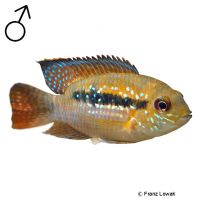Blue Spot Acara (Andinoacara coeruleopunctatus)
| Blue Spot Acara Andinoacara coeruleopunctatus | |
|---|---|
| Name | Blue Spot Acara |
| Name Lat. | Andinoacara coeruleopunctatus |
| Synonym | Aequidens coeruleopunctatus |
| Family | Cichlids |
| Family lat. | Cichlidae |
| Order | Cichlids |
| Order lat. | Cichliformes |
| Origin | Panama, Costa Rica |
| Habitat | Rivers, streams |
| Diet | Carnivore |
| pH | 5.5-7.5 |
| Behavior | Territorial |
| Keeping | Pair |
| Care Level | Moderate |
| Reproduction | Substrate spawner |
| Breeding | Moderately difficult |
| Life Span | 7-10 years |
| Protection | No |
| Metric Units | |
| Size | 15-18 cm |
| Temperature | 22-29 °C |
| Hardness | 2-10 °dH |
| Aquarium | ~ 350 l |
| US Units | |
| Size | 6"-7" |
| Temperature | 72-84 °F |
| Hardness | 36-178 ppm |
| Aquarium | ~ 90 gal |
Distribution and habitat
The Chogorro cichlids are distributed from the Rio Coto in Costa Rica to Panama and the Rio San Juan in Colombia. They live there in stagnant, turbid waters, but also in clear, free-flowing streams and rivers.
Maintenance
The aquarium should have a robust border planting, with many hiding places (stones, roots) and offer free swimming space. A substrate of sand or fine gravel covered with some foliage (e.g. sea almond leaves) and slightly subdued light (floating plants) is ideal.
No ammonia, ammonium and nitrite should be detectable, the nitrate value should not exceed 100 mg/l. To ensure the water quality and oxygen content, a filter and heater adapted to the aquarium size is required, as well as lighting for the species-appropriate day-night rhythm of the animals.
Diet
In the wild they feed mainly on small crustaceans, insect larvae and plankton. The food supply consists of live, frozen and dry food. For a balanced diet, feed once a day with a high-quality dry food for cichlids (flakes, granules, pellets) as well as daphnia, artemia, mysis, tubifex and mosquito larvae (live or frozen)
Only feed as much as will be eaten within a few minutes. Regular and varied feeding promotes health and increases resistance
Behaviour and compatibility
They should be kept in pairs. At spawning time they behave very territorial, therefore keeping several pairs is only recommended in a larger and richly structured tank. They can be socialized well with other calm fish, but defend their territory consistently.
Basically, only compatible fish species with similar demands on water quality and water temperature may be socialized.
Sex dimorphism
The male is larger, more colorful and has much longer, pointed fins. The female, which is smaller and rounder, shows an intense red-purple colored belly during the spawning season.
Reproduction and breeding
They spawn on flat stones, roots or leaves (substrate spawners). Predominantly the female performs the brood care while the male defends the territory. After 2-3 days the fry hatch and are housed in a trough and swim free after about 5 days. The school of fry is guarded by the parents for some time and led to the feeding places in the aquarium before the brood care ends.
Fry must be fed several times a day with special rearing food. In community tanks breeding is hardly possible, because the young fish are easy prey here.
Important
The addition of peat extract or filtering through peat promotes the well-being of the animals and increases their color intensity
The well-being of the fish should be checked regularly. Temperature should be checked daily, pH, hardness and nitrate levels at least fortnightly. Regular partial water changes are recommended, even if the pollutant level has not yet reached the upper limit. Sudden changes in water quality should be avoided. Newly introduced fish must be accustomed slowly to the water in the aquarium.
Further literature can be found in your pet store.
References
Text: Werner Winter; Image: Franz Lowak
Source: BMELV (1998): Tierschutzgutachten - Haltung von Zierfischen (Süßwasser); BAENSCH & RIEHL (2006): Aquarien Atlas Bd. 2, Mergus Verlag; ENGELMANN (2005): Zootierhaltung - Tiere in menschlicher Obhut: Fische, Verlag Harri Deutsch
- Gemäß § 21 Abs. 5 Tierschutzgesetz idgF
